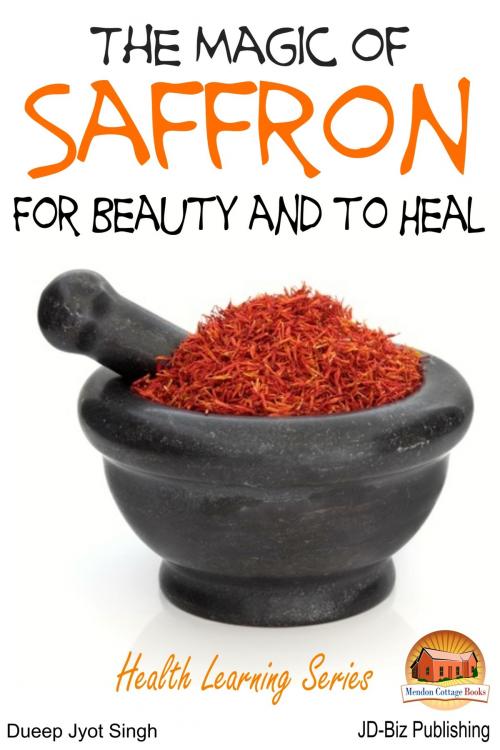| Author: | Dueep Jyot Singh | ISBN: | 9781310606069 |
| Publisher: | Mendon Cottage Books | Publication: | April 6, 2015 |
| Imprint: | Smashwords Edition | Language: | English |
| Author: | Dueep Jyot Singh |
| ISBN: | 9781310606069 |
| Publisher: | Mendon Cottage Books |
| Publication: | April 6, 2015 |
| Imprint: | Smashwords Edition |
| Language: | English |
Table of Contents
The Magic of Saffron
Introduction
Saffron Test
How to Use Saffron?
Cultivating Saffron
Right Soil for Saffron
Preparation of the Soil
Crocus Diseases and Infections
Harvesting Your Saffron
Drying of Saffron
Using Saffron in Cuisine
Traditional Cooling Saffron – Almond Drink
Saffron for Beauty and Health
Saffron for Lightening the Complexion
Beauty lotion
Saffron to Cure Diseases
Depression Cure
Getting Rid of Kidney Stones
Saffron as a Cold Preventative and Cure
Saffron Milk
Saffron as a Headache Remedy
Best Moisturizing Lotion
Saffron for Women’s Personal Health
Teething problems
Appendix
Where Do You Get Edible Camphor?
Conclusion
Author Bio
Publisher
Introduction
The moment you hear the word “saffron”, your immediate reaction is the vision of an exotic, valuable and very expensive spice. You may also think of a golden – orangeish color.
The term saffron comes from the Persian term Zaferan for orange gold. That is because the Persians were supposed to be the first of the culinary gourmets to use saffron in cooking. They already knew all about the healing qualities of this precious spice and used it extensively in medicine. But when they found out that just a couple of stigmas of the precious crocus was able to give their dishes a lovely tint, aroma, and look, saffron came into popular usage.
It is also said that saffron was used extensively in China, more than 2000 years ago, where it was used in herbal medicine. A saffron plant had up to four flowers. Each of them had three Crimson and bright stigmas. These stigmas are the most precious providers of saffron in their dried form.
In ancient Greece, which is also a contender for “we discovered saffron first,” the people of Minoan and Cretan origin painted beautiful paintings of saffron collectors on their walls. Santorini excavations, going back to the Bronze Age, – more than 5000 years ago have extremely well defined frescoes of saffron collectors , wearing their native garb.
This plant, belongs to the crocus family, and is called Crocus Sativus. It is supposed to be a native of Southwest Asia, from where it slowly and steadily spread to North America, North Africa, and Europe.
As time went by, and people began to use new sea routes to discover brave brand-new worlds, the demand for more and more saffron began to grow, especially in ancient civilizations where cuisine and the standard of living was steeped in luxury. This is why the conquering Romans who could not do without crocus, make sure that wherever they went, they did take some crocus bulbs and corms along with them. Since those long gone days, this is considered to be one of the most expensive and exotic of spices known to mankind.
Table of Contents
The Magic of Saffron
Introduction
Saffron Test
How to Use Saffron?
Cultivating Saffron
Right Soil for Saffron
Preparation of the Soil
Crocus Diseases and Infections
Harvesting Your Saffron
Drying of Saffron
Using Saffron in Cuisine
Traditional Cooling Saffron – Almond Drink
Saffron for Beauty and Health
Saffron for Lightening the Complexion
Beauty lotion
Saffron to Cure Diseases
Depression Cure
Getting Rid of Kidney Stones
Saffron as a Cold Preventative and Cure
Saffron Milk
Saffron as a Headache Remedy
Best Moisturizing Lotion
Saffron for Women’s Personal Health
Teething problems
Appendix
Where Do You Get Edible Camphor?
Conclusion
Author Bio
Publisher
Introduction
The moment you hear the word “saffron”, your immediate reaction is the vision of an exotic, valuable and very expensive spice. You may also think of a golden – orangeish color.
The term saffron comes from the Persian term Zaferan for orange gold. That is because the Persians were supposed to be the first of the culinary gourmets to use saffron in cooking. They already knew all about the healing qualities of this precious spice and used it extensively in medicine. But when they found out that just a couple of stigmas of the precious crocus was able to give their dishes a lovely tint, aroma, and look, saffron came into popular usage.
It is also said that saffron was used extensively in China, more than 2000 years ago, where it was used in herbal medicine. A saffron plant had up to four flowers. Each of them had three Crimson and bright stigmas. These stigmas are the most precious providers of saffron in their dried form.
In ancient Greece, which is also a contender for “we discovered saffron first,” the people of Minoan and Cretan origin painted beautiful paintings of saffron collectors on their walls. Santorini excavations, going back to the Bronze Age, – more than 5000 years ago have extremely well defined frescoes of saffron collectors , wearing their native garb.
This plant, belongs to the crocus family, and is called Crocus Sativus. It is supposed to be a native of Southwest Asia, from where it slowly and steadily spread to North America, North Africa, and Europe.
As time went by, and people began to use new sea routes to discover brave brand-new worlds, the demand for more and more saffron began to grow, especially in ancient civilizations where cuisine and the standard of living was steeped in luxury. This is why the conquering Romans who could not do without crocus, make sure that wherever they went, they did take some crocus bulbs and corms along with them. Since those long gone days, this is considered to be one of the most expensive and exotic of spices known to mankind.















